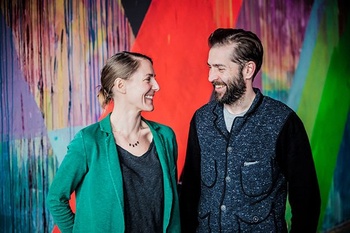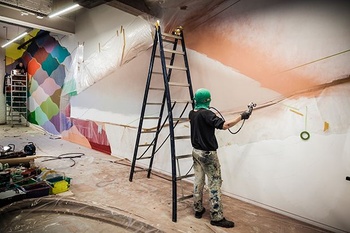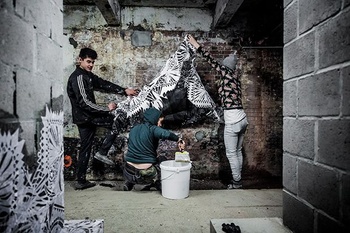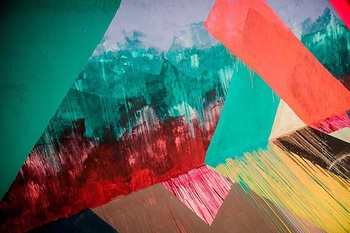Challenging persistent imagery in an effort to create new connections, that is in a nutshell the ambitious idea behind Brussels’s newest cultural hotspot: the Millennium Iconoclast Museum of Art.
MIMA
The MIMA – short for Millennium Iconoclast Museum of Art – was supposed to have opened a week ago, but history decided otherwise. Brussels is still shaking. The aftershocks of yet another act of complete and utter senselessness are again being felt in the already heavily affected cultural sector. The distress is great, but the determination to counter sadness, fury, and loss with warmth, an open heart and neighbourly love is all the greater. The same is true for Raphaël Cruyt and Alice van den Abeele, the duo behind Alice Gallery and the recently opened flexible exhibition space/artist studio/meeting place Encore, and now also – along with Michel and Florence de Launoit – the brain and heart behind the brand-new museum. “I feel empty,” Alice van den Abeele says the day after the attacks in Zaventem and Brussels, just a few days since our interview that took place surrounded by dust and paint brushes at a MIMA which at that point was still bustling with the race to the opening day. “I don’t know… This is… No, I’m more sure now than ever that we need to go through with this.”
“This” is the project they have been physically tackling for a little less than a year, but have been planning for at least a year and a half longer. In January 2015, they came across the 1,000 m2 building of the former Belle-Vue brewery, located in Henegouwenkaai 33 quai du Hainaut, next to the Meininger hotel. “When we saw this building, we knew we didn’t have a choice. Either we did it there and then or the train would pass and the opportunity would be gone,” says Alice van den Abeele. Raphaël Cruyt: “Exactly. There was no discussion. We fell head over heels for this place. For an art centre, the building, the spatial experience is so important. It’s not just about art, it’s also about creating a context for art, or rather the other way around: inserting art in a given context. To us, this location in the Canal Zone is meaningful, it goes straight to the point.”

“It’s not like we were specifically looking for a spot in Molenbeek,” clarifies Alice van den Abeele. “First and foremost, to give this project a chance, we needed it to be in the centre, somewhere easily reachable by tourists as well. Being able to really add something, is a bonus we’re grateful for.” Raphaël Cruyt: “Precisely, we’re very lucky to get this opportunity. I think the place reflects the value of the MIMA, as we see it. It represents this cultural diversity, this multicultural idea that you can link to how the internet changed our way of thinking.”
BEYOND THE BORDERS
The internet. Over the last twenty years, this strange virtual reality of its early days has evolved into a very real parallel environment influencing the world we see when we’re not looking at our screens, or at least the way we look at them. It is also where Raphaël Cruyt and Alice van den Abeele feel like the origin and identity of the MIMA are grounded. Raphaël Cruyt: “At the turn of the millennium, a lot of artists were looking for new ways to express themselves. Galleries provided a context that was too narrowing, people were becoming more and more mobile and didn’t want to choose between one and the other. You had skateboarders writing on walls or starting their own skateboard company, comic artists wanting to exhibit their work. They just wanted to be able to shift contexts and identities, leave behind the differences between high and low, and bring culture closer to the way they lived their lives.”

“Look at all those DIY subcultures,” Raphaël Cruyt continues, “which, just like urban art, were believed for a long time to be ephemeral. But we now see that urban art is bigger than anything else, while it isn’t managed or directed by anyone. The internet created a way for the general public, that was eagerly taking pictures and sharing them online, to be heard. It really works from the bottom up, it’s like a new kind of democracy, a new way to be connected to the arts scene, away from the isolation of those white gallery walls. This shift, which the internet helped to promote, reflected a renewed creative spirit, a participative, emphatic approach, and a mobility with regards to identity and register. It is about an enrichment, on the level of both content and connection.”

Both of those aspects come into view when looking at the focus the MIMA has chosen. The collection – consisting of about forty works – and temporary exhibitions focus on art that functions as an intersection of elements from the visual, musical, graphic, cinematic, and urban cultures. Raphaël Cruyt: “It’s what we call the 2.0 culture. Culture without boundaries, based only on the will of the artists to express themselves, whatever way they choose to do so. Culture isn’t territorialised anymore; look at the internet: it doesn’t matter where you are at. You notice that even classical cultural institutions are slowly evolving towards that perspective, you can feel their need to create a bridge.”
CREATING CONNECTIONS
A bridge is exactly what the MIMA aims to be, according to the duo. “The reason we chose a museum is because it offers you the possibility to have a vision of the past, the present, and the future, all at the same time,” says Raphaël Cruyt. “It narrows the scope and the debate. It allows you to create intelligence around a topic. And that’s especially important in a time where we’re living in a constant stream of information. Culture doesn’t come through a straight canal, it comes from everywhere, so it is difficult sometimes to connect everything together in that stream. The museum is the place where we can accumulate knowledge and stimulate reflection. The more you do that, the more intelligent people will become. It would be amazing to eventually engage those people to share their interests and ideas. It could be some sort of participative democracy. It’s all about creating connections, a community. I deeply believe that could happen.”
“It’s the same for the artists in the show. Each of them has their own universe, so they have different outputs, but they share a way to engage in their work with this emphatic feeling, this collaborative effort, this mobile way of thinking. Maya Hayuk, Swoon, Momo, and the artist duo Faile – all five of them New Yorkers – have known each other for almost ten years. So it is not only about aesthetics, but also about friendship, and the atmosphere and energy it brings.”
EXPECT THE UNEXPECTED
The quintet is nothing if not energetic, as we can see when we explore the building. The “Diamond Room”, which Maya Hayuk has filled from floor to ceiling with her geometric colour explosions, is nothing less than an experience. Momo is still working hard on his wall and Swoon has occupied the cellar for an impressive session of gluing till you drop, to the enlivening rhythm of infectious African beats. The two gentlemen of Faile will only arrive in Brussels the next day, but their installation has preceded them. Raphaël Cruyt: “There is still a lot of work, yeah. But it will be great once it is finished. Expect the unexpected. [Laughs] You know, the title for the exhibition, ‘City Lights’, is a reference to the 1931 Chaplin movie. Chaplin plays a tramp, who, while falling in love with a blind flower girl and trying to help her out, faces the reality of the city – itself a seductive character, but really tough at the same time. The city lights at the end of the story are not the lights of the commercial streets, it is the people who inspire the city. That idea really appealed to me. We want this museum to offer an experience, to inspire the city. It’s not about what you see on the outside, it’s what is on the inside that matters, that which you didn’t expect to see.”

“You can easily link that to Molenbeek. This part of town has an amazing mix of cultures, but what the museum can really bring, what I feel is missing, is a social mix. This building could improve the context for everybody. Again, it could be a bridge. A way to rebalance this image that survived from the beginning of the 20th century, when Molenbeek was called ‘Little Manchester’, because of the riots and strikes that came from this part of town. The image of a dangerous neighbourhood was sown in those days.”
“What happened in November was a shock for everyone. Molenbeek was a no-go area, living there was enough to be considered a terrorist. But when it’s your home, that’s not the image you get. I box in a club here. And you see these kids with their T-shirts with ‘I love Molenbeek’ prints on them. It was a statement, a way to show they were not going to accept this image. They wanted to stand up against that image and face it. Just like the museum. Iconoclast, exactly!”
CITY LIGHTS
15/4 > 28/8, MIMA, mimamuseum.eu
Read more about: Expo , Cultuurnieuws
Fijn dat je wil reageren. Wie reageert, gaat akkoord met onze huisregels. Hoe reageren via Disqus? Een woordje uitleg.